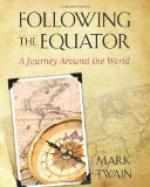Population 1851, 185,000. The increase is due mainly to the introduction of Indian coolies. They now apparently form the great majority of the population. They are admirable breeders; their homes are always hazy with children. Great savers of money. A British officer told me that in India he paid his servant 10 rupees a month, and he had 11 cousins, uncles, parents, etc., dependent upon him, and he supported them on his wages. These thrifty coolies are said to be acquiring land a trifle at a time, and cultivating it; and may own the island by and by.
The Indian women do very hard labor [for wages of (1/2 rupee) for twelve hours’ work.] They carry mats of sugar on their heads (70 pounds) all day lading ships, for half a rupee, and work at gardening all day for less.
The camaron is a fresh water creature like a cray-fish. It is regarded here as the world’s chiefest delicacy—and certainly it is good. Guards patrol the streams to prevent poaching it. A fine of Rs.200 or 300 (they say) for poaching. Bait is thrown in the water; the camaron goes for it; the fisher drops his loop in and works it around and about the camaron he has selected, till he gets it over its tail; then there’s a jerk or something to certify the camaron that it is his turn now; he suddenly backs away, which moves the loop still further up his person and draws it taut, and his days are ended.
Another dish, called palmiste, is like raw turnip-shavings and tastes like green almonds; is very delicate and good. Costs the life of a palm tree 12 to 20 years old—for it is the pith.
Another dish—looks like greens or a tangle of fine seaweed—is a preparation of the deadly nightshade. Good enough.
The monkeys live in the dense forests on the flanks of the toy mountains, and they flock down nights and raid the sugar-fields. Also on other estates they come down and destroy a sort of bean-crop—just for fun, apparently—tear off the pods and throw them down.
The cyclone of 1892 tore down two great blocks of stone buildings in the center of Port Louis—the chief architectural feature-and left the uncomely and apparently frail blocks standing. Everywhere in its track it annihilated houses, tore off roofs, destroyed trees and crops. The men were in the towns, the women and children at home in the country getting crippled, killed, frightened to insanity; and the rain deluging them, the wind howling, the thunder crashing, the lightning glaring. This for an hour or so. Then a lull and sunshine; many ventured out of safe shelter; then suddenly here it came again from the opposite point and renewed and completed the devastation. It is said the Chinese fed the sufferers for days on free rice.




